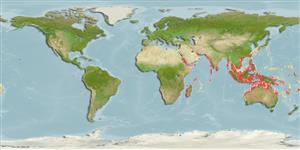Actinopterygii (ray-finned fishes) >
Beloniformes (Needle fishes) >
Hemiramphidae (Halfbeaks)
Etymology: Rhynchorhamphus: Greek, rhingchos = snout + Greek,rhamphos = bill (Ref. 45335).
Environment / Climate / Range
Ecology
Marine; freshwater; brackish; pelagic-neritic; depth range 0 - ? m. Tropical, preferred ?
Indo-West Pacific: the most widespread of the four species of Rhynchorhamphus, found from Persian Gulf through Arabian Sea and Bay of Bengal through the Western Central Pacific north to Taiwan and Hong Kong and east to New Guinea and northern Australia.
Length at first maturity / Size / Weight / Age
Maturity: Lm ?, range 15 - 16.5 cm
Max length : 31.0 cm male/unsexed; (Ref. 10943)
Found in inshore waters (Ref. 75154). Enters freshwaters (Ref 13446).
Life cycle and mating behavior
Maturity | Reproduction | Spawning | Eggs | Fecundity | Larvae
Collette, B.B. and J. Su, 1986. The halfbeaks (Pisces, Beloniformes, Hemiramphidae) of the Far East. Proc. Acad. Nat. Sci. Philadelphia 138(1):250-301. (Ref. 10943)
IUCN Red List Status (Ref. 115185)
CITES (Ref. 94142)
Not Evaluated
Threat to humans
Harmless
Human uses
Fisheries: minor commercial
Tools
Special reports
Download XML
Internet sources
Estimates of some properties based on models
Phylogenetic diversity index (Ref.
82805): PD
50 = 0.5625 [Uniqueness, from 0.5 = low to 2.0 = high].
Bayesian length-weight: a=0.00257 (0.00117 - 0.00566), b=3.16 (2.97 - 3.35), in cm Total Length, based on LWR estimates for this (Sub)family-body shape (Ref.
93245).
Trophic Level (Ref.
69278): 3.1 ±0.2 se; Based on size and trophs of closest relatives
Resilience (Ref.
69278): High, minimum population doubling time less than 15 months (K>1).
Vulnerability (Ref.
59153): Low vulnerability (13 of 100) .
